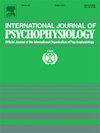心相和呼吸相对听觉诱发电位的影响。
IF 2.5
3区 心理学
Q3 NEUROSCIENCES
引用次数: 0
摘要
脑-体相互作用在外部刺激的知觉和认知加工中起着至关重要的作用。先前的研究已经研究了心脏阶段(收缩期、舒张期)和呼吸阶段(吸气、呼气)是如何影响各种心理功能的,尽管它们对听觉处理的影响的研究结果仍然不一致。本研究探讨了心相和呼吸相是否影响听觉ERP成分,特别是N1和P2。为了控制与心脏相关的伪影,纯音(70 dB)和无声刺激(0 dB)以交替的随机间隔呈现,并通过从音调引起的波形中减去无声刺激引起的波形来计算ERP差异波形。对不同的参与者进行了两个实验:观看视频而忽略音调(实验1)或在观看视频时尽可能快地按下按钮以响应音调(实验2)。结果显示,N1振幅在心脏和呼吸阶段之间没有显着差异。舒张期P2振幅明显大于收缩期,但效应值较小(dz = 0.26)。对于呼吸相,当参与者忽略音调时,呼气时P2振幅比吸气时更大(dz = 0.35),但当他们注意音调时,这种影响消失了。这些发现表明,内脏传入信号可能通过调节不同心脏和呼吸阶段的注意力资源分配来影响听觉加工。本文章由计算机程序翻译,如有差异,请以英文原文为准。
Effects of cardiac and respiratory phases on auditory evoked potentials
Brain-body interactions play a crucial role in the perceptual and cognitive processing of external stimuli. Previous research has examined how cardiac phases (systole, diastole) and respiratory phases (inhalation, exhalation) influence various psychological functions, though findings on their impact on auditory processing remain inconsistent. This study investigated whether cardiac and respiratory phases affect auditory ERP components, specifically N1 and P2. To control for cardiac-related artifacts, pure tones (70 dB) and silent stimuli (0 dB) were presented in alternating, randomized intervals, and ERP difference waveforms were computed by subtracting waveforms elicited by silent stimuli from those elicited by tones. Two experiments were conducted with different participants: watching a video while ignoring the tones (Experiment 1) or pressing a button as quickly as possible in response to the tones while watching the video (Experiment 2). Results showed no significant differences in N1 amplitude between cardiac or respiratory phases. P2 amplitude was significantly larger at diastole than systole, although the effect size was small (dz = 0.26). For respiratory phases, P2 amplitude was greater during exhalation than inhalation when participants ignored the tones (dz = 0.35), but this effect disappeared when they attended to the tones. These findings suggest that visceral afferent signals may influence auditory processing by modulating attentional resource allocation across different cardiac and respiratory phases.
求助全文
通过发布文献求助,成功后即可免费获取论文全文。
去求助
来源期刊
CiteScore
5.40
自引率
10.00%
发文量
177
审稿时长
3-8 weeks
期刊介绍:
The International Journal of Psychophysiology is the official journal of the International Organization of Psychophysiology, and provides a respected forum for the publication of high quality original contributions on all aspects of psychophysiology. The journal is interdisciplinary and aims to integrate the neurosciences and behavioral sciences. Empirical, theoretical, and review articles are encouraged in the following areas:
• Cerebral psychophysiology: including functional brain mapping and neuroimaging with Event-Related Potentials (ERPs), Positron Emission Tomography (PET), Functional Magnetic Resonance Imaging (fMRI) and Electroencephalographic studies.
• Autonomic functions: including bilateral electrodermal activity, pupillometry and blood volume changes.
• Cardiovascular Psychophysiology:including studies of blood pressure, cardiac functioning and respiration.
• Somatic psychophysiology: including muscle activity, eye movements and eye blinks.

 求助内容:
求助内容: 应助结果提醒方式:
应助结果提醒方式:


